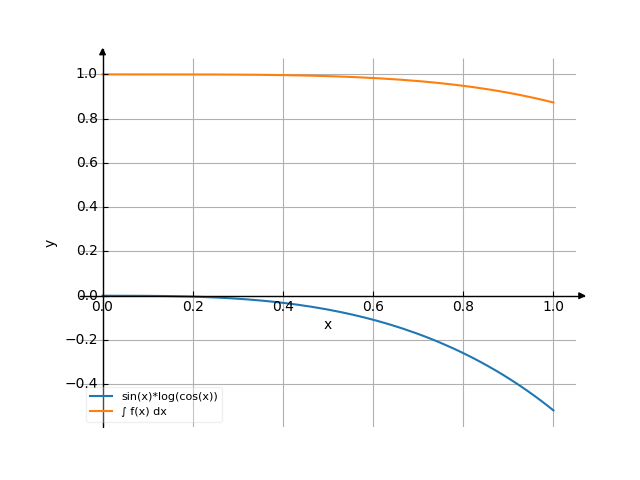Integral of sinxlncosx dx
The solution
You have entered
[src]
1 / | | sin(x)*log(cos(x)) dx | / 0
$$\int\limits_{0}^{1} \log{\left(\cos{\left(x \right)} \right)} \sin{\left(x \right)}\, dx$$
Integral(sin(x)*log(cos(x)), (x, 0, 1))
Detail solution
-
There are multiple ways to do this integral.
Method #1
-
Let .
Then let and substitute :
-
The integral of a constant times a function is the constant times the integral of the function:
-
Use integration by parts:
Let and let .
Then .
To find :
-
The integral of the exponential function is itself.
Now evaluate the sub-integral.
-
-
The integral of the exponential function is itself.
-
So, the result is:
-
Now substitute back in:
Method #2
-
Use integration by parts:
Let and let .
Then .
To find :
-
The integral of sine is negative cosine:
Now evaluate the sub-integral.
-
-
The integral of sine is negative cosine:
-
-
Now simplify:
-
Add the constant of integration:
The answer is:
The answer (Indefinite)
[src]
/ | | sin(x)*log(cos(x)) dx = C - cos(x)*log(cos(x)) + cos(x) | /
$$\cos x-\cos x\,\log \cos x$$
The graph
The answer
[src]
-1 - cos(1)*log(cos(1)) + cos(1)
$$-\cos 1\,\log \cos 1+\cos 1-1$$
=
=
-1 - cos(1)*log(cos(1)) + cos(1)
$$-1 - \log{\left(\cos{\left(1 \right)} \right)} \cos{\left(1 \right)} + \cos{\left(1 \right)}$$
The graph

Use the examples entering the upper and lower limits of integration.

![Find the integral of y = f(x) = sinxlncosx dx (sinus of xln co sinus of e of x) - with detailed solution [THERE'S THE ANSWER!] sinxlncosx](/media/krcore-image-pods/176/hash/indefinite/b/39/9e882fe7147e0832af207e5641156.png)
 Integral of sqrt(1+x^2)/x^2
Integral of sqrt(1+x^2)/x^2
 Integral of ln(1+x^2)dx
Integral of ln(1+x^2)dx
 Integral of cos^2(x)dx
Integral of cos^2(x)dx
 Integral of dx/(2-3*x)
Integral of dx/(2-3*x)